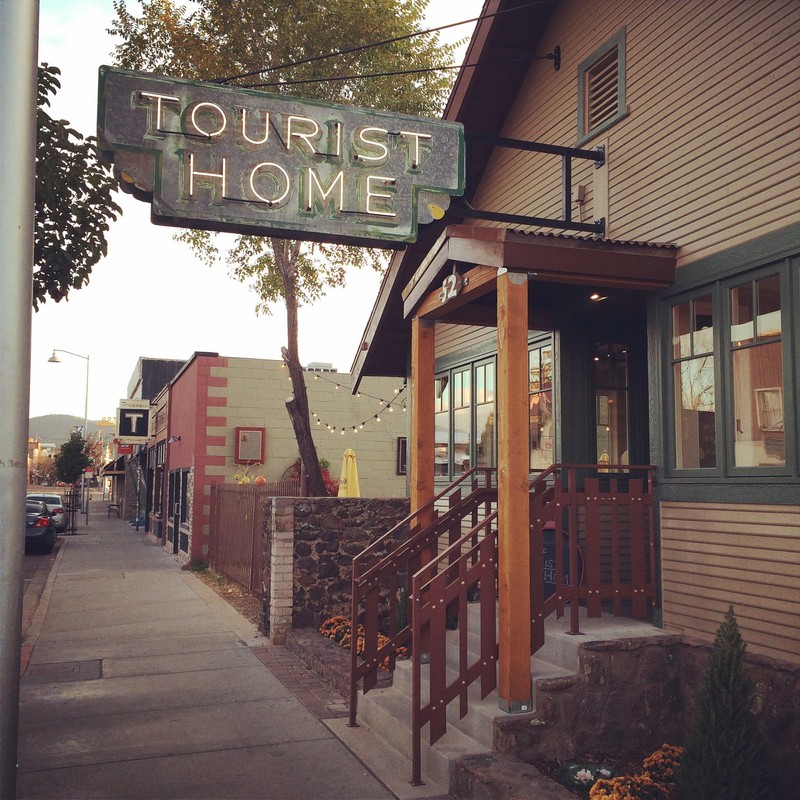Basque Handball Court & Tourist Home Building
Introduction
Text-to-speech Audio
Images
Tourist Home All Day Cafe was once a historic boarding house where Basque sheepherders and laborers stayed. They played handball court in the adjacent court area that now serves as outdoor seating space.

Backstory and Context
Text-to-speech Audio
Spanish explorer Francisco Vázquez de Coronado first introduced sheep to the Southwest in 1540. It is likely these sheep didn't survive but another explorer, Juan de Oñate, brought sheep into what is now New Mexico in 1598. The Navajo Indians probably pushed these sheep into northeastern Arizona in the early 1600s. It took another century before sheep were reintroduced to Arizona by Padre Eusebio Kino. This time, he brought breeding sheep and thereby established the sheep industry in the Southwest.
The industry grew over the next couple of centuries so that by 1917 there were around 1.4 million sheep in Arizona. To reach other ranges in Arizona, sheepherders led flocks from the summer grazing grounds in the Colorado Plateau to the winter grazing grounds in Phoenix Basin and Central Arizona. A part of this journey was to cross a bridge that spanned the Verde River north of Phoenix (a replica bridge was built in 1989 and is open to pedestrians).
Large numbers of Basque and other immigrants arrived in Arizona at the-turn-of-the century. They initially lived in hotels or boarding houses, like the Tourist Home, and maintained their language, customs and traditions. Among these was the game of handball, which they called Pilotaleku in the Basque language (it is "pelota" in Spanish). The pelota ball was small, hard and handmade using goatskin. Players either hit it with their hand or a sling that resembled a basket. Courts were near or next to the hotel or boarding house. Handball is remains a popular sport today.
Among the Basque who immigrated to America were members of the Auza and Manterola families, who were sheepherders in the Pyrenees Mountains. They became successful and their descendants continue to sheepherding today, although the industry has been in decline.
It is not apparent when the Tourist Home stopped operating as a boarding house but it was left vacant for four decades and fell into disrepair (it was, in fact, condemned). After a substantial renovation effort, the current owners opened the cafe in October 2014.
Sources
"Basque in Our Awesomeness." Tourist Home All Day Cafe. Accessed February 22, 2020. https://www.touristhomecafe.com/about.
Bruner, Betsy. "Basque culture: Unique and worth preserving." January 23, 2012. https://azdailysun.com/basque-culture-unique-and-worth-preserving/article_dfbfaeb8-5520-532e-9104-d53cb191ea96.html.
Betz, Eric. "Flagstaff's historic Tourist Home set for sale." Daily Sun. February 27, 2014. https://azdailysun.com/business/local/flagstaffs-historic-tourist-home-set-for-sale/article_862edba2-9f7a-11e3-8db4-001a4bcf887a.html.
Garibay, B. "Hanging on by a thread: Manterola, Auza and Pouquette families shape northern Arizona sheep industry." Williams-Grand Canyon News. October 1, 2019. https://www.williamsnews.com/news/2019/oct/01/hanging-thread-manterola-auza-and-pouquette-famili.
Heinonen, Kevin. "Flagstaff has its own Phoenix." October 25, 2019. https://www.touristhomecafe.com/post/2019/10/25/flagstaff-has-its-own-phoenix.
"The Verde River Sheep Bridge." Cornerstone Environmental. Accessed September 21, 2020. https://www.cornerstone-environmental.com/publications/item/the-verde-river-sheep-bridge.
Tourist Home All Day Cafe
